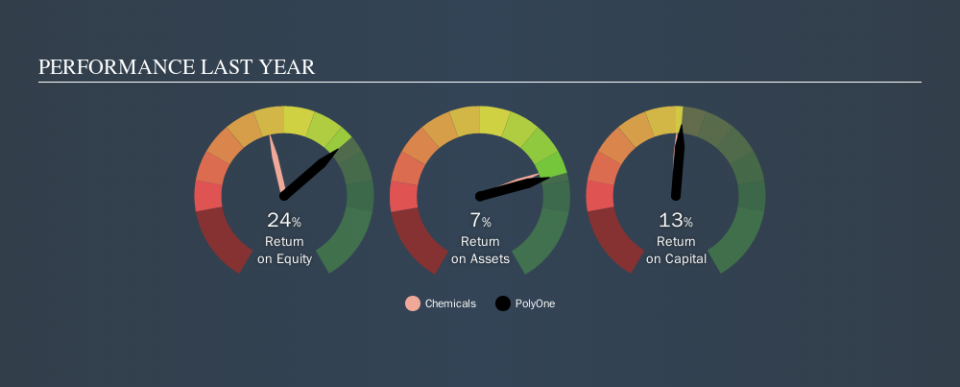PolyOne Corporation (NYSE:POL) Earns Among The Best Returns In Its Industry

Today we are going to look at PolyOne Corporation (NYSE:POL) to see whether it might be an attractive investment prospect. To be precise, we'll consider its Return On Capital Employed (ROCE), as that will inform our view of the quality of the business.
First up, we'll look at what ROCE is and how we calculate it. Second, we'll look at its ROCE compared to similar companies. Last but not least, we'll look at what impact its current liabilities have on its ROCE.
Understanding Return On Capital Employed (ROCE)
ROCE is a measure of a company's yearly pre-tax profit (its return), relative to the capital employed in the business. In general, businesses with a higher ROCE are usually better quality. Overall, it is a valuable metric that has its flaws. Author Edwin Whiting says to be careful when comparing the ROCE of different businesses, since 'No two businesses are exactly alike.
So, How Do We Calculate ROCE?
Analysts use this formula to calculate return on capital employed:
Return on Capital Employed = Earnings Before Interest and Tax (EBIT) ÷ (Total Assets - Current Liabilities)
Or for PolyOne:
0.13 = US$291m ÷ (US$2.9b - US$626m) (Based on the trailing twelve months to September 2019.)
Therefore, PolyOne has an ROCE of 13%.
See our latest analysis for PolyOne
Is PolyOne's ROCE Good?
ROCE is commonly used for comparing the performance of similar businesses. In our analysis, PolyOne's ROCE is meaningfully higher than the 10% average in the Chemicals industry. I think that's good to see, since it implies the company is better than other companies at making the most of its capital. Regardless of where PolyOne sits next to its industry, its ROCE in absolute terms appears satisfactory, and this company could be worth a closer look.
You can see in the image below how PolyOne's ROCE compares to its industry. Click to see more on past growth.
When considering ROCE, bear in mind that it reflects the past and does not necessarily predict the future. ROCE can be misleading for companies in cyclical industries, with returns looking impressive during the boom times, but very weak during the busts. ROCE is only a point-in-time measure. Since the future is so important for investors, you should check out our free report on analyst forecasts for PolyOne.
How PolyOne's Current Liabilities Impact Its ROCE
Liabilities, such as supplier bills and bank overdrafts, are referred to as current liabilities if they need to be paid within 12 months. The ROCE equation subtracts current liabilities from capital employed, so a company with a lot of current liabilities appears to have less capital employed, and a higher ROCE than otherwise. To check the impact of this, we calculate if a company has high current liabilities relative to its total assets.
PolyOne has total liabilities of US$626m and total assets of US$2.9b. Therefore its current liabilities are equivalent to approximately 21% of its total assets. A fairly low level of current liabilities is not influencing the ROCE too much.
The Bottom Line On PolyOne's ROCE
This is good to see, and with a sound ROCE, PolyOne could be worth a closer look. There might be better investments than PolyOne out there, but you will have to work hard to find them . These promising businesses with rapidly growing earnings might be right up your alley.
For those who like to find winning investments this free list of growing companies with recent insider purchasing, could be just the ticket.
We aim to bring you long-term focused research analysis driven by fundamental data. Note that our analysis may not factor in the latest price-sensitive company announcements or qualitative material.
If you spot an error that warrants correction, please contact the editor at editorial-team@simplywallst.com. This article by Simply Wall St is general in nature. It does not constitute a recommendation to buy or sell any stock, and does not take account of your objectives, or your financial situation. Simply Wall St has no position in the stocks mentioned. Thank you for reading.

